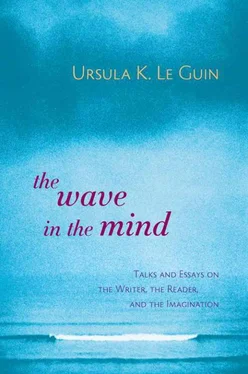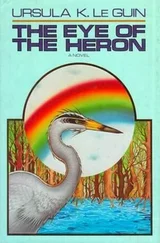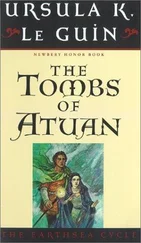We stiffened it with celluprime and then we veneered it down, about seven thousand layers. Each one has plastic of at least two molecular thicknesses. This mouse can’t spoil. As a matter of fact, this mouse is going to go on thinking forever. He won’t think much, unless we put the voltage on him, but he’ll think. And he can’t spoil…. I told you, this mouse is going to be thinking when the last human being on the last known planet is dead. And it’s going to be thinking about that girl. Forever.
The mouse does protect her, through the projection of various fantasies, which I no longer find as implausible as I did, because I now see that in fact she is protectable. She is not the inevitable victim I took her for. Veesey has strength and courage; she meets the danger posed by her psychotic male companions with stoicism: “Life’s life, she thought, and I must live it. Here.” Her reaction to her own Daughter Potential is stoical endurance—“Is it child again? she thought to herself.” She’s a woman, not a child, and she knows it if they don’t. (She is, in fact, remarkably like some of Dickens’s much-ridiculed heroines, Lizzie Hexam, Amy Dorrit, Florence Dombey, who, though the male characters see them as childish, and many readers follow suit, are in fact strong, courageous, adult women, survivors against all odds.) She is childlike only in the depth of her innocence. At the most frightening moment she asks the rapist, “Is this what crime is, what you are doing to me?” But the allegory is of an Innocence stronger than Experience—of a genuinely inviolable soul.
And the sick bits, I now realise, are not self-indulgent, as so much literary rape and torture is. Trying to say something seriously about who men are, what their chief problem may be, Smith found these were the images to say it with—the necessary vocabulary.
The apparitions summoned by Sh’san to save Veesey from the men and the men from themselves are much more complicated and psychologically tricky than I had thought. Since they bring about the happy ending, they can partake in high comedy; and they do, especially the last one, the ship’s captain:
“If I stop to think about it, I find myself pretty upsetting. I know that I’m just an echo in your minds, combined with the experience and wisdom which has gone into the cube. So I guess that I do what real people do. I just don’t think about it very much. I mind my business.” He stiffened and straightened and was himself again. “My own business,” he repeated.
“And Sh’san,” said Trece, “how do you feel about him?”
A look of awe—almost a look of terror—came upon the captain’s face…. “Sh’san. He is the thinker of all thinking, the ‘to be’ of being, the doer of doings. He is powerful beyond your strongest imagination. He makes me come living out of your living minds. In fact,” said the captain with a final snarl, “he is a dead mouse brain laminated with plastic and I have no idea at all of who I am. Good night to you all!”
The captain set his cap on his head and walked straight through the hull.
This reality-shifting also contains one of Smith’s central and to me most fascinating themes: that of the animal as savior. The engineer who created the cube imprinted his own personality in it, the minds of the girl and the two men create the apparitions, the girl’s imprinted call for help switches on the voltage that activates the cube—but the saving energy lies, finally, in the brain of a dead mouse.
The mouse is worth remembering.
THE UNDERPEOPLE
It’s easy to remember Smith’s great Underpeople savior figures—D’joan the dog woman, the pure sacrificial figure; E-tele-keli, man and eagle, who flies deep under Old Earth; and of course, threading her way like a wandering red flame through the stories and the novel, C’mell the girlygirl, all woman and all cat.
In stories where animal and human are mixed in the way Smith mixed them, the human body dominating but possessing animal characteristics, the effect is usually horrible or pitiful: the Minotaur or the awful creatures of Dr. Moreau’s island.
Here is B’dikkat, the cattle-person of Shayol, Smith’s version of the Minotaur:
An enormous face, four times the size of any human face Mercer had ever seen, was looking down at him. Huge brown eyes, cowlike in their gentle inoffensiveness, moved back and forth as the big face examined Mercer’s wrapping. The face was that of a handsome man of middle years, clean-shaven, hair chestnut-brown, with sensual, full lips and gigantic but healthy yellow teeth exposed in a half-smile. The face saw Mercer’s eyes open, and spoke with a deep friendly roar.
The mixture is very strange and not horrible at all; the bull and the man are each there, blended but uncontaminated, with their own nature and their own beauty.
When human and animal can mix so completely, they are, by implication, the same. An identity has been asserted.
In Norstrilia, the eponymous setting of Smith’s one novel, an immortality drug, stroon, or the santaclara drug, is made from the exudations of enormous, sick sheep. The countryside is dotted with these sheep, big as airplane hangars, immobile, diseased. By their endless dying they furnish untold wealth and eternal life to their human owners.
Animal sacrifice is a very widespread human custom. The little dead mouse, the dying sheep of Norstrilia, may be seen as animal sacrifices to ensure human welfare. But the Underpeople’s suffering and their sacrifice in the person of D’joan extend and enlarge the theme. It is unmistakably a human sacrifice—also a fairly widespread human custom. D’joan’s life points to Joan of Arc, of course, and behind that, to the humiliation and death of Jesus.
The “Old Strong Religion,” one of Smith’s fine phrases, is mentioned in several stories, but he never does much with it. In a way it would seem more appropriate if the Old Strong Religion were, not Christianity as it evidently is, but Buddhism. The Compassionate Buddha can be incarnate as any creature, as a mother tiger, as a little jackal, as a bird, as a mouse. Smith does not share the Judeo-Christian exclusive focus on one species, the exclusion from sacredness of everything but the human. His stories say that the death of an animal counts the same, weighs the same, as the death of a human. That animal and human are equally sacred. That salvation can lie in the death of a dog, as in the death of a god.
This is pretty subversive stuff. Smith’s attitude towards authority is complex. He loves to tell us about people who are immensely powerful and supernally rich—the Lords and Ladies of the Instrumentality, the Misters and Owners of Norstrilia, such as the boy who bought Old Earth. Linebarger’s familiarity with the corridors of power must have fed this fascination, and also fueled Smith’s visions of people in power who learn to be worthy of their power, who become just, compassionate, and wise. Their wisdom leads them to subvert their own orderly, static, perfect society, to reinvent freedom, ordaining the Rediscovery of Man, when “everywhere, men and women worked with a wild will to build a more imperfect world.”
But wisdom, compassion, and justice fail them when it comes to the Underpeople. Here they still have something to learn. Here the Judeo-Christian division still obtains. The Underpeople are nonpeople, they have no rights, no souls, they are things that exist to serve Man. Like any machine or slave, if useless or rebellious they are to be destroyed. At this point, in this division, lies the ethical crux of Smith’s strongest stories.
“Alpha Ralpha Boulevard” serves well to illustrate the themes. In a corridor under the earth (the twelve-mile-high Earthport and the deep underground are recurrent, contrasted loci) the narrator Paul and his Virginia are threatened by a monstrous, Dr. Moreauish, drunken version of the bull-man. They are saved from it by a woman, who tells them, “Come no closer. I am a cat.” When Paul thanks her and asks her name, she says, “Does it matter? I’m not a person.”
Читать дальше



